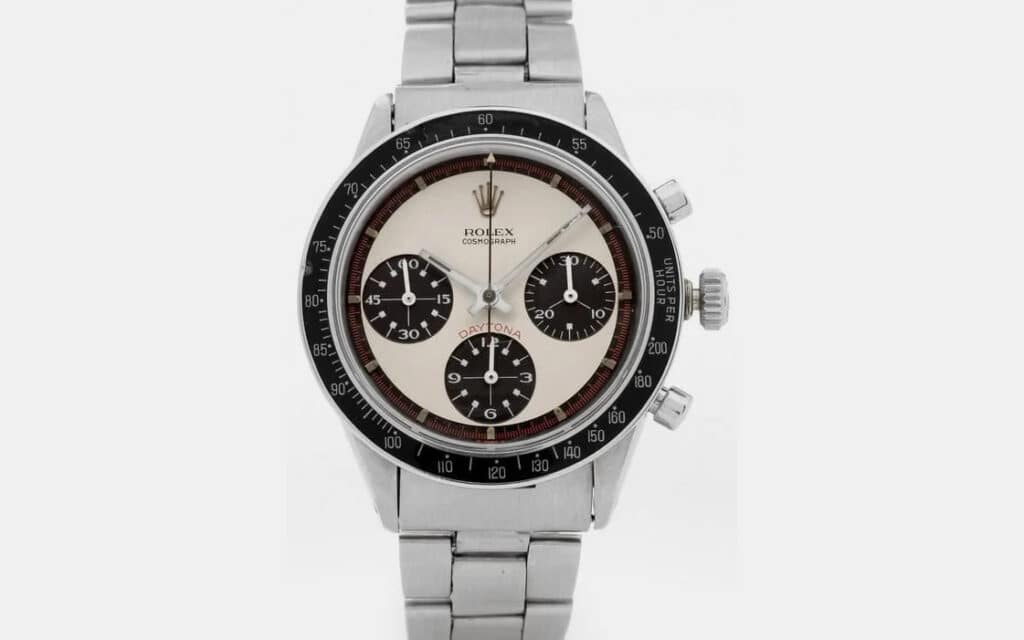In a way, the Rolex Cosmograph Daytona is the Babe Ruth of chronographs. The mere mention of either sparks thoughts of record-breaking statistics and superlatives. We forget that before his 714 home runs, Ruth held a 30-year record for strikeouts in baseball. Similarly, the history of the iconic Rolex Daytona reminds us that it was so unpopular at first, Rolex considered stopping its production. Not to mention the Cosmograph’s failed bid for space exploration at the hands of Omega’s Speedmaster.
This coveted chronograph is now the highest-selling Rolex line in auction. Famously, Paul Newman’s is the third highest-selling watch in history. The line is associated with auto racing and named after the Daytona Speedway in Florida. However, its checkered journey to becoming a historical and cultural icon starts long before we were even calling it a Daytona, and even before we called it a Cosmograph.
The Pre-Daytonas
Rolex was dabbling in monopushers since the late 1930s, so what one considers the first Pre-Daytona depends on the benchmark used. Considering its aforementioned lucrativeness in the second market, several early reference numbers have been dubbed “Pre-Daytona” in auction catalogs. Specifically, Reference 4500 is worth noting. Its side-by-side subdials, tachymeter-telemeter scale, and now-common 2 and 4 o’clock pushers mark an earnest move into chronograph production for Rolex.
A far less controversial pick as the original Cosmograph patriarch is Reference 6234, which was in production from 1955 to 1961. Neither “Cosmograph” nor “Daytona” was marked anywhere on its body.
Though it would serve as the template for all future Daytonas, the 6234 wasn’t successful. Breitling had already created the first chronograph with a 30-minute counter and a central seconds hand in 1915. An official Olympics timekeeper in the ‘30s, Omega chronographs were used as stopwatches at the games. As far as chronos went, Rolex just wasn’t the watch world’s go-to. Plot twist: Today, you’d be lucky to get a 6234 for $20k.
From the 6234 came the 6238, which got rid of the 6234’s telemeter scale. Then from the 6238, came the Cosmograph 6239.
The Cosmograph makes tracks at Daytona
Legendary race car driver Sir Malcolm Campbell notably sported a Rolex Oyster at Daytona in the 1930s. He even wrote Rolex a thank you letter, praising its durability on the track. It’s fitting that in 1962, Rolex became the official timekeeper for the Daytona International Speedway. To commemorate the partnership, the crown released Reference 6239, which bears the “Cosmograph” appellate. Since the Cosmograph 6239 was made especially for racecar drivers, a bezel engraved with a tachymeter was added. It proved exceedingly useful for calculating average lap speed.
It was also given two nicknames: “Le Mans” after the 24-hour French race, and “Daytona,” after the racetrack. A year after its release, Rolex added “Daytona” to the 6239’s dial, graduating the popular nickname into official status.
The 1960s also saw Rolex making the “Suggested List of Manufacturers” for space exploration, coordinated by NASA engineer James H. Ragan and astronaut Deke Slayton.
Sadly, like Apollo Creed did Rocky Balboa, the Omega Speedmaster knocked the Rolex Cosmograph out in the final round. Rolex Cosmo left space and headed back to the racetrack.

Newman’s own
The first series of Cosmograph Daytonas were produced from 1963 to the 1980s. You can distinguish these guys from the other two serieses because they have four-digit reference numbers and a manual-winding movement. Rolex sourced their movement from Swiss manufacturer, Valijoux. Since these early Daytonas were produced in small portions, they’re the rarest breed today.
Hollywood actor, salad-builder, and racecar driver, Paul Newman, famously wore an exotic dial Daytona on and off the track. First appearing in 1965, exotic dials feature a contrasting seconds scale along the edge of the dial, but come in many styles distinct from the core colorway. Stainless steel versions often come in black with white sub-registers or vice versa. They sometimes use different fonts for the numerals or feature a sunken outer seconds track that match the subdials.
These remixed Daytonas were made for a short period per production cycle. Newman commonly wore one on a leather military strap, and was often photographed Daytona-clad from 1972 up until his passing in 2008. The exotics were dubbed “Paul Newman” Daytonas in the ‘80s, decades before one would break all records at Phillips Auction house in 2017. Paul Newman’s 6239 sold for a whopping $17.1million.
The Second Series goes automatic
By the late ‘80s, the Daytona’s history as an unpopular ugly duckling was far behind it. Demand far outweighed supply, so Rolex created Reference 16520 in 1988, launching the Second Series of Cosmographs, those with five-digit reference numbers instead of four.
These Daytonas feature several visual changes, including a 40mm case from the original 37mm, subdials color-matched to the rest of the dial, and a color-contrasted outer track. They were also upgraded with modern elements. The dial protector, once acrylic, was replaced with a harder and more scratch-resistant sapphire crystal, and the dial was given a sleek and glossy finish. On the inside, these new generation timepieces ran on a modified automatic winding movement.
Rolex sourced this automatic caliber from fellow Swiss watchmaker, Zenith. Built for Zenith’s El Primero chronograph in 1969, the high-beat Calibre 3019PHC boasts 360,000 vibrations per hour, or 5 Hz. To this day, this is the highest VPH for any chronograph movement that’s mass produced. The Second Series Daytonas proved to be reliable and accurate, and were produced in limited amounts during its run from 1988 to 2000.
One distinguished variant is the Chairman Daytona Reference 16528. An eye-catching aristocrat of a watch, the Chairman made its debut in 1991. It was also referred to as “Big Blue” because of its trademark blue dial, which was galvanized, coated with a protective zinc layer. The Chairman’s tachymeter also went up to 400 units per hour. The white gold Reference 16519 and the yellow gold Reference 16518 were partnered with leather straps, giving sporty Daytona a seat at the dress watch table.
As Rolex started to vertically integrate in the ‘90s, it set the stage for the next series, one that would encapsulate all the best practices we associate with the crown.
The Third Series goes in-house
At the dawn of the millennium, the Cosmograph was equipped with an in-house automatic movement. Rolex’s very own Calibre 4130 runs on 44 jewels, boasts a 72-hour power reserve, 280,800 vibrations per hour, and hacking capabilities.
Its hairspring is the brand’s in-house Parachrom Bleu. It has a paramagnetic niobium and zirconium alloy construction, which basically just means it’s fully unaffected by magnetic fields. The niobium, which makes up 85% of the hairspring, makes the mechanism extremely resistant to heat and pressure. Since the hairspring controls the speed of the watch’s inner wheels, this means a superior rate of movement for the hands.
Naturally, every Series Three Daytona is a certified chronometer. Certification from the Official Swiss Chronometer Testing Institute (aka the COSC) ensures that these durable chronographs have been subjected to rigorous tests for strength, precision, and overall quality.
On the cosmetic front, these new Daytonas feature two subdials at the 9 and 3 o’clock positions, and the seconds subdial now sits at the 6 o’clock position instead of its previous 9 o’clock post. The Panda Dial Daytona is a popular variation that also came out in 2000, featuring a black bezel, white dial, and white subdials heavily outlined in stark black.

The Cosmograph Daytona Today
The Rolex Cosmograph Daytona is one of the most famous chronographs in the world. Hardcore fans and crown tribalists often rank it above the Omega Speedmaster. Its crossover appeal gets it onto all sorts of wrists from Michael Jordan’s and Michael Strahan’s to Jonah Hill’s to Jay Z’s and Victoria Beckham’s.
Contemporary Daytonas feature a 40mm case and come in every construction. Of course, they’ve got white and yellow gold, as well as Rolex’s Everose, which takes the traditional rose gold formula (copper and gold), and replaces the gold with platinum. This makes it stronger, with a pink tone that will literally never fade. There’s also Rolex’s Oystersteel, their proprietary 904L stainless steel, which has far better corrosion resistance and luster than your everyday stainless steel.
Function-wise, they still run on the COSC-certified 4130 automatic movement, accurate between -2 and +2 seconds a day. The oyster case features the patented screwdown caseback, bezel, and winding crown. Rolex’s Triplock crown has three sealed zones for extra waterproofness.
In recent years, a Daytona Reference 6265 sold for almost $6 million in Geneva, a Paul Newman Big Red Daytona Reference 6263 sold for $5.4 million in New York, and Reference 6062 sold for $5.3 million, also in Geneva. In fact, Rolex is exclusively represented by the Cosmograph Daytona in the top 15 list of highest-selling watches, which is dominated by Patek Philippe.
In 2021, Sotheby’s London sold an 18k gold Rolex Daytona for an unprecedented $1.5 million during an online auction. Breaking the record for the highest-selling wrist watch sold online, the Cosmograph Daytona continues to be relevant and popular in the internet auction age.
You May Also Like: Rolex Daytona Alternatives For every Budget
Disclosure: Clicking on these links and making a purchase may earn us a small referral fee, at no extra cost to you. Learn more here.



